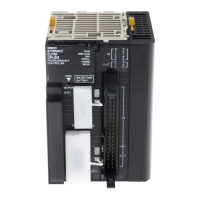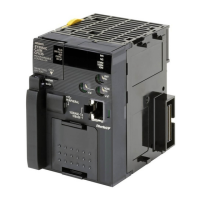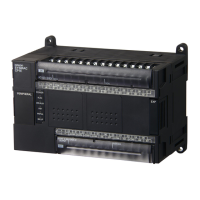Do you have a question about the Omron CX-PROGRAMMER - INTRODUCTION GUIDE and is the answer not in the manual?
Detailed steps for installing CX-Programmer software on a PC.
Guide to inserting the CD-ROM and starting the CX-Programmer installation wizard.
Process for registering the product online after installation for user benefits.
How to launch the CX-Programmer application from the Windows start menu.
Steps to create a new project and configure the PLC device type.
Explanation of the primary interface elements of the CX-Programmer main window.
Configuring keyboard shortcuts to emulate the SYSWIN interface for familiar operation.
How to create, rename, and organize program logic into functional sections.
Methods to show or hide various windows like Project Workspace and Output Window.
Step-by-step guide to adding a normally open contact element in ladder logic.
Instructions for adding a coil output element to the ladder program.
How to add or modify descriptive text for symbols used in the program.
Adding descriptive comments to individual rungs for better program understanding.
Step-by-step guide to adding a normally closed contact element in ladder logic.
How to attach detailed comments to program instructions or contacts.
Using the differential contact instruction that triggers on the rising edge of a bit.
Using the differential contact instruction that triggers on the falling edge of a bit.
Adding vertical contacts to the ladder diagram, specifically for upward transitions.
Adding vertical contacts to the ladder diagram, specifically for downward transitions.
How to use advanced instructions, focusing on string manipulation.
Exploring various useful functions within advanced instructions, including help features.
Using a specific auxiliary relay function for a 1.0-second clock pulse.
Implementing differential instructions that execute only once per scan.
How to create a logical OR condition within a ladder rung.
Using function numbers to specify advanced instructions like MOV.
Adding and configuring timer instructions within the ladder program.
Adding and configuring counter instructions within the ladder program.
Efficiently duplicating or moving rungs within the ladder program.
Understanding the automatic generation of the END instruction in new projects.
Performing a compile to check for errors before transferring the program to the PLC.
Connecting CX-Programmer to the PLC or simulator for online operations.
Observing the real-time status of contacts and coils in monitor mode.
Splitting the ladder window to monitor several program locations simultaneously.
Switching the display format of IO memory values between decimal and hexadecimal.
Adding and monitoring specific PLC addresses in a dedicated Watch Window.
Changing present values and monitoring data in binary format within the Watch Window.
Managing data displays in the Watch Window by creating and renaming sheets.
Adding PLC addresses to the Watch Window by dragging them from the ladder diagram.
Adjusting display to wrap long rungs for better readability on screen.
Detecting and indicating up/down changes in specified bits for efficient debugging.
Manually setting the ON/OFF state of contacts and coils for testing.
Listing all bits currently being forced ON or OFF for quick status checks.
Modifying the preset value of a timer while the PLC is running in monitor mode.
Adjusting the current accumulated value of a timer during online monitoring.
Locating all occurrences of a specific PLC address within the project.
Following the logic flow backwards to find the root cause of issues in ladder rungs.
Searching for PLC addresses or words based on keywords found in program comments.
Navigating directly to a specific rung based on its associated comment.
Searching for specific bit addresses and displaying their usage in the program.
Modifying program logic directly while the PLC is online.
Detailed steps for installing CX-Programmer software on a PC.
Guide to inserting the CD-ROM and starting the CX-Programmer installation wizard.
Process for registering the product online after installation for user benefits.
How to launch the CX-Programmer application from the Windows start menu.
Steps to create a new project and configure the PLC device type.
Explanation of the primary interface elements of the CX-Programmer main window.
Configuring keyboard shortcuts to emulate the SYSWIN interface for familiar operation.
How to create, rename, and organize program logic into functional sections.
Methods to show or hide various windows like Project Workspace and Output Window.
Step-by-step guide to adding a normally open contact element in ladder logic.
Instructions for adding a coil output element to the ladder program.
How to add or modify descriptive text for symbols used in the program.
Adding descriptive comments to individual rungs for better program understanding.
Step-by-step guide to adding a normally closed contact element in ladder logic.
How to attach detailed comments to program instructions or contacts.
Using the differential contact instruction that triggers on the rising edge of a bit.
Using the differential contact instruction that triggers on the falling edge of a bit.
Adding vertical contacts to the ladder diagram, specifically for upward transitions.
Adding vertical contacts to the ladder diagram, specifically for downward transitions.
How to use advanced instructions, focusing on string manipulation.
Exploring various useful functions within advanced instructions, including help features.
Using a specific auxiliary relay function for a 1.0-second clock pulse.
Implementing differential instructions that execute only once per scan.
How to create a logical OR condition within a ladder rung.
Using function numbers to specify advanced instructions like MOV.
Adding and configuring timer instructions within the ladder program.
Adding and configuring counter instructions within the ladder program.
Efficiently duplicating or moving rungs within the ladder program.
Understanding the automatic generation of the END instruction in new projects.
Performing a compile to check for errors before transferring the program to the PLC.
Connecting CX-Programmer to the PLC or simulator for online operations.
Observing the real-time status of contacts and coils in monitor mode.
Splitting the ladder window to monitor several program locations simultaneously.
Switching the display format of IO memory values between decimal and hexadecimal.
Adding and monitoring specific PLC addresses in a dedicated Watch Window.
Changing present values and monitoring data in binary format within the Watch Window.
Managing data displays in the Watch Window by creating and renaming sheets.
Adding PLC addresses to the Watch Window by dragging them from the ladder diagram.
Adjusting display to wrap long rungs for better readability on screen.
Detecting and indicating up/down changes in specified bits for efficient debugging.
Manually setting the ON/OFF state of contacts and coils for testing.
Listing all bits currently being forced ON or OFF for quick status checks.
Modifying the preset value of a timer while the PLC is running in monitor mode.
Adjusting the current accumulated value of a timer during online monitoring.
Locating all occurrences of a specific PLC address within the project.
Following the logic flow backwards to find the root cause of issues in ladder rungs.
Searching for PLC addresses or words based on keywords found in program comments.
Navigating directly to a specific rung based on its associated comment.
Searching for specific bit addresses and displaying their usage in the program.
Modifying program logic directly while the PLC is online.











